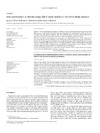Please use this identifier to cite or link to this item:
https://accedacris.ulpgc.es/jspui/handle/10553/47025
| Title: | Does innovation in obesity drugs affect stock markets?: an event study analysis | Authors: | Pérez Rodríguez, Jorge Vicente González Lopez-Valcarcel, Beatriz |
UNESCO Clasification: | 531207 Sanidad | Keywords: | Obesidad Medicamentos Modelo de mercado |
Issue Date: | 2012 | Publisher: | 0213-9111 | Journal: | Gaceta Sanitaria | Abstract: | Objective: This study empirically analyzes the effects of public information about the pharmaceutical R&D process on the market valuation of the sponsoring firm. We examined the market’s response to scientific news and regulatory decisions about an antiobesity drug, rimonabant, and the effects on the sponsoring company (Sanofi-Aventis) and its incumbent competitors (Abbott and Roche). Methods: Event study methodology was used to test the null hypothesis of no market response. We covered the full life cycle of rimonabant (1994-2008), using a data set of daily closing price and volume. Results: The results suggest that scientific news in the initial stages of the drug R&D process (i.e., drug discovery, preclinical and clinical trials) had no significant effects. However, news related to regulatory decisions, such as recall or safety warning, had significant negative effects on the company’s market value. No spillover/contagion effects on competitor firms were detected. Conclusion: Market reactions occur at the time when the regulator takes decisions about drugs. Scientific news, even those of high-impact, may pass unnoticed. Objetivo: Este trabajo analiza empíricamente los efectos de la información pública sobre la I+D en la valoración de mercado de una empresa farmacéutica. Examinamos la respuesta del mercado a las noticias científicas y a las decisiones de regulación de un medicamento para la obesidad, el rimonabant (Sanofi-Aventis), sobre la propia compa˜nía y sobre sus competidoras (Abbott y Roche). Métodos: Se aplicó la metodología de estudio de eventos para contrastar la hipótesis de ausencia de respuesta del mercado. Cubrimos el ciclo de vida completo del rimonabant (1994-2008), utilizando una base de datos de precio y volumen de negociación diarios al cierre. Resultados: Los resultados sugieren que las noticias científicas en las etapas iniciales del proceso de I+D (es decir, el descubrimiento del fármaco y los ensayos preclínicos y clínicos) no tuvieron efectos significativos, pero las noticias relacionadas con las decisiones regulatorias (retirada o alerta de seguridad) sí tuvieron efectos negativos significativos en el valor de mercado de la empresa. No se detectaron efectos cruzados en las empresas competidoras. Conclusión: Las reacciones de los mercados se producen en el momento en que el regulador toma decisiones sobre medicamentos. Las noticias científicas, incluso las de gran impacto, pueden pasar desapercibidas. |
URI: | https://accedacris.ulpgc.es/handle/10553/47025 | ISSN: | 0213-9111 | DOI: | 10.1016/j.gaceta.2011.07.028 | Source: | Gaceta Sanitaria[ISSN 0213-9111],v. 26, p. 352-359 |
| Appears in Collections: | Artículos |
SCOPUSTM
Citations
5
checked on Jun 8, 2025
WEB OF SCIENCETM
Citations
3
checked on Jun 8, 2025
Page view(s)
81
checked on Apr 27, 2024
Download(s)
115
checked on Apr 27, 2024
Google ScholarTM
Check
Altmetric
Share
Export metadata
Items in accedaCRIS are protected by copyright, with all rights reserved, unless otherwise indicated.
